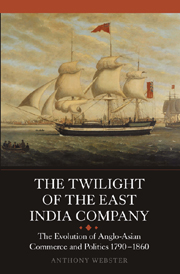 The Twilight of the East India Company
The Twilight of the East India Company Book contents
- Frontmatter
- Contents
- Preface
- 1 Introduction: The end of the East India Company, the historians and the evolution of Anglo-Indian commerce and politics
- 2 The origins of the East India Company and the rise of non-Company commercial interests in Britain, India and Asia, 1600–1793
- 3 War, politics and India: The battle for the East India Company trade monopoly, 1793–1813
- 4 Accommodating free trade: India, the East India Company and the commercial revolution of 1814–1830
- 5 Crisis and trade liberalisation 1830–1834: Financial chaos and the end of the East India Company's commercial role and privileges
- 6 Re-ordering Anglo-Asian commerce and politics: 1833–1847
- 7 Crisis, the resurgence of London and the end of the East India Company: 1847–1860
- 8 Conclusion: The decline of the East India Company and the evolution of British commercial and political interests in Asia, 1793–1860
- Notes
- Bibliography
- Index
1 - Introduction: The end of the East India Company, the historians and the evolution of Anglo-Indian commerce and politics
Published online by Cambridge University Press: 12 September 2012
- Frontmatter
- Contents
- Preface
- 1 Introduction: The end of the East India Company, the historians and the evolution of Anglo-Indian commerce and politics
- 2 The origins of the East India Company and the rise of non-Company commercial interests in Britain, India and Asia, 1600–1793
- 3 War, politics and India: The battle for the East India Company trade monopoly, 1793–1813
- 4 Accommodating free trade: India, the East India Company and the commercial revolution of 1814–1830
- 5 Crisis and trade liberalisation 1830–1834: Financial chaos and the end of the East India Company's commercial role and privileges
- 6 Re-ordering Anglo-Asian commerce and politics: 1833–1847
- 7 Crisis, the resurgence of London and the end of the East India Company: 1847–1860
- 8 Conclusion: The decline of the East India Company and the evolution of British commercial and political interests in Asia, 1793–1860
- Notes
- Bibliography
- Index
Summary
THE EAST INDIA COMPANY has fascinated and divided historians, yet its importance for the development of the British Indian Empire is one of the few aspects of the Company's history on which there is some measure of consensus. Founded in London in 1600 as a monopolistic joint stock venture to engage in speculative trade with the Far East, the Company struggled through its first 150 years of existence. There were major problems both at home and abroad, notably the effects of civil war in the 1640s and, more seriously, the disintegration of the Mughal Empire from the late seventeenth century onwards. The latter development, however, precipitated major changes in the Company. Forced to defend itself against some of the new Indian states emerging from the fragmenting Mughal Empire, as well as older European rivals, the Company became a military as well as a commercial organisation. A turning point came in 1757, when hostilities with Sirajudaullah, Nawab of Bengal, prompted the annexation of that province by the Company. It set in train a process of expansion which by 1830 saw the East India Company establish itself as effective ruler of India. By then, recurrent financial crises had forced the Company to solicit the help of the British state, which was forthcoming, but at the price of government control over the organisation.
- Type
- Chapter
- Information
- The Twilight of the East India CompanyThe Evolution of Anglo-Asian Commerce and Politics, 1790–1860, pp. 1 - 17Publisher: Boydell & BrewerPrint publication year: 2009
